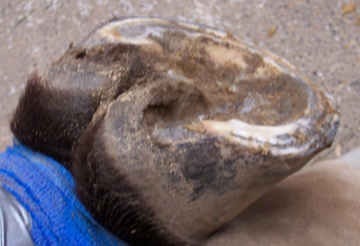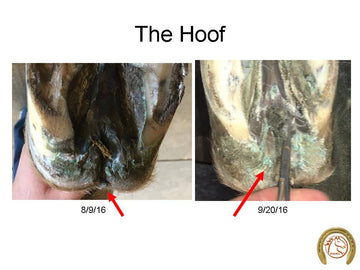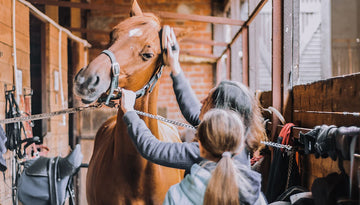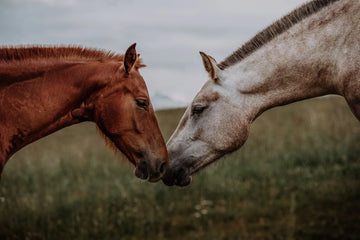Retracted soles are a condition that many equine professionals have seen but has yet been defined or described in any equine medical dictionary.1,.2 There are only a few published or electronic references to retracted soles that can be found. 3-11
There are a couple proposed theories as to the causes (etiology), conditions, and the actual mechanisms involved in causing a retracted sole. 4,5,7-11 The appearance cannot be mistaken for any other sole issue. Instead of having a nice sole concavity, the sole appears to drop off from the white line (Figures 1, 2 and 3). The soles of a horse with retracted soles appear to be drawing up and away from the ground. The soles appear to be being sucked up into the hoof. Horses with retracted soles are many times thought to be or diagnosed as being laminitic, severe sole soreness, and/or having abscesses.
Retracted soles that go unnoticed by a farrier during the trimming process can result in overly trimming the hoof wall thus causing the horse to become extremely painful due to sole pressure. The good news is that proper farrier treatment can have a dramatic improvement with lameness and potential long term side effects from retracted soles.
Etiology (Causes) of Retracted Soles
There has not been any known published research into the etiology or cause of retracted soles. Retracted sole appears most prevalent in the spring and fall months when horses are frequently out in muddy paddocks or pastures. As mentioned earlier, horses with retracted soles are many times thought to be or diagnosed as being laminitic, severe sole sore and/or having abscesses. They are positive to hoof tester response and, in many cases, positive to the slightest thumb pressure on the soles. Retracted soles are thin and abnormally cupped.
Observations From the Published References 3-11
- Retracted soles are specific and may not affect other horses in the same environment.
- Retracted soles have been documented in many breeds of Horse’s, Draft’s, and Donkey’s.
- Some horse’s, no matter how treated, always maintained their retracted soles.
- Not all horses with retracted soles are lame.
- Horses with retracted soles have extremely thin soles.
- Horses with thin soles, predominantly Thoroughbreds, are most susceptible to retracted soles.
- Retracted soles have been documented in many other countries.
- A turned-out animal with one or more retracted soles may come up lame suddenly.
- Animals with retracted soles in both front feet can be mistaken to have laminitis because the presentation is similar.
- Retracted sole animals walk better on a hard, flat surface, unlike most foot-lame horses that are more comfortable on a soft surface.
- They can be helped by placing them into a clean dry stall (key being dry), if the bedding does not ball up in the feet.
- Retracted soles can be observed in animals in wet and muddy as well as dry, dewy and humid environments.
- Correct farrier treatment with sole protection usually returned the sole to normal thickness within 6-12 weeks.
- Removing the horse from the muddy environment was ideal to help alleviate the retracted soles however in reality was not practical most of the time.
- Some possible causes can be a combination of environmental, mechanical, nutritional, and autoimmune problems.
- Many horses with retracted soles also seem to have contracted and/or underrun heels.
As you can see from the radiograph in Figure 4, if a farrier trims down too much of the hoof wall at the toe, this horses’ already thin sole will be extremely close to the ground. The normal sole thickness ranges from 10 to 15 mm. Any sole thickness less than 10 mm is considered to be a thin sole. It has been determined that is takes 3-5 mm to house the vascular supply under the coffin bone in the sole. The horse in the radiograph (Figure 4) has a sole depth of 6.5mm.
Treatment for Retracted Soles
The farrier must not trim the sole and remove only enough hoof wall to balance the limb.4,6,7,8 Retracted soles that go unnoticed by a farrier during the trimming process can result in overly trimming the hoof wall thus causing the horse to become extremely painful due to thin soles. Farrier recognition of retracted soles is critical to limiting over trimming of the hoof wall. It will appear as if you’re leaving more hoof wall than normal, but this is an optical illusion due to the sole being retracted and overly thin.
There are several options that have shown to work depending on the severity of the retracted soles. Removing the horse from the muddy environment is ideal but, is not practical most of the time.
Horses that are not lame can benefit from application of hardening products such as Venice turpentine12, Keratex Hoof Hardener13, etc. Removing them from the wet and muddy environment and stalling in a clean and dry stall for a time can help with keeping them from becoming lame until the sole thickness returns.
Horses that appear lame due to retracted soles are much more comfortable in some form of shoes and sole protection products or pads. Hoof boots have had limited success in the treatment of retracted soles due to holding water and mud in the boots. Most horses shod with shoes with sole protection will have the sole return to normal concavity within 6 to `12 weeks.
In some cases, the horse will always need to be in shoes with sole protection4,7 as the sole thickness will not return to a normal. It is theorized that the sole corium can become damage to the point that normal sole production is limited or unable to grow new sole. Several horses have been reported to have permanent retracted soles thus it is encouraged to have correct farriery and sole protection sooner than later.
Clearly further research is needed as well as identifying the cause(s) for this hoof dilemma. For further information, please go to the references to find links to other written materials.


Figure 2 – A slight retracted sole.

Figure 3 – Retracted Sole on a Canker Case. The blood helps accent the retraction.

Figure 4 – Radiograph of a horse with a Retracted Sole. The ideal sole depth is between 10 and 15 mm. The horse in the radiograph (Figure 4) has a sole depth of 6.5 mm.

Figure 5 – Case Study horse radiograph before shoeing.

Figure 6 – Case Study horse radiograph six weeks after shoeing showing significant and excessive sole depth now.
References and Further Information
- Saunders Comprehensive Veterinary Dictionary, 3rd Blood DC, Studdert VP and Gay CC. Elsevier Ltd, 2007.
- Taber’s Cyclopedic Medical Dictionary, 21st FA Davis Company, Philadelphia, Pennsylvania, 2009.
- Horse Breeding and Management. James Warren Evans. Elsevier Science Publishers BV, Amsterdam, The Netherlands, 1992; 22.6.3 Encastellated Feet, page 157.
- Balancing the Horse and Hoof Problems. Esco Buff. Lecture handout, 2000.
- The Principles of Horseshoeing (P3). Doug Butler and Jacob Butler. Doug Butler Enterprises, Inc, LaPorte, Colorado, 2004; page 159.
- americanfarries.com/pages/forum/heel-spring.php. (American Farriers Journal, Forum, Trimming and Shoeing, Heel Springs). Reply from Esco Buff, PhD, CF at 06/03/2007, 7:33am.
- facebook.com/escobuff. Case Study, 2009.
- How to Recognize and Treat Retracted Soles. Esco Buff. 2012 International Hoofcare Summit, Cincinnati, Ohio. PowerPoint lecture.
- https://www.americanfarriers.com/articles/11156-retracted-soles-an-unfortunate-side-effect-of-wet-weather. (American Farriers Journal, Lameness, Therapeutic Shoeing). One of the wettest years in history is prompting more retracted sole cases. June 18, 2019.
- https://blog.easycareinc.com/my-horse-has-retracted-soles/. My horses Has Retracted Soles? December 4, 2012.
- https://www.integrativehoofschool.com/blog/retracted-soles-broader-perspective. Daisy Bicking blog. Unknown date.
- Hawthorne Products. https://hawthorne-products.com/
- Keratex Hoof Hardener. https://www.keratex.com/product/keratex-hoof-hardener/









